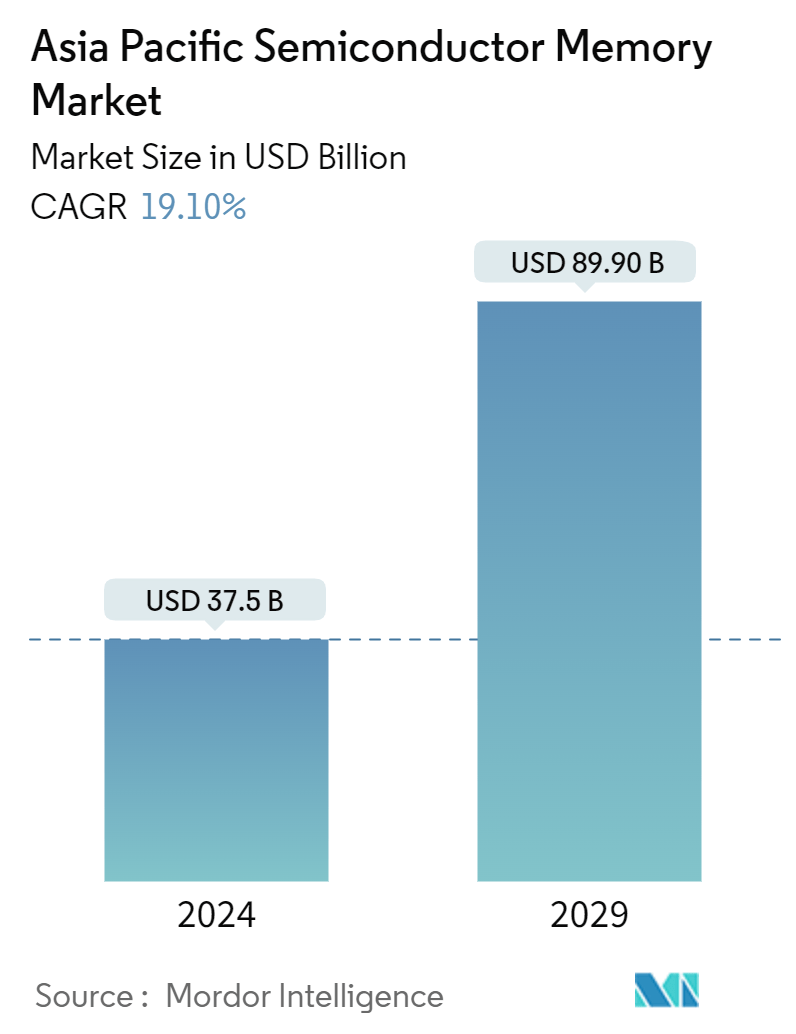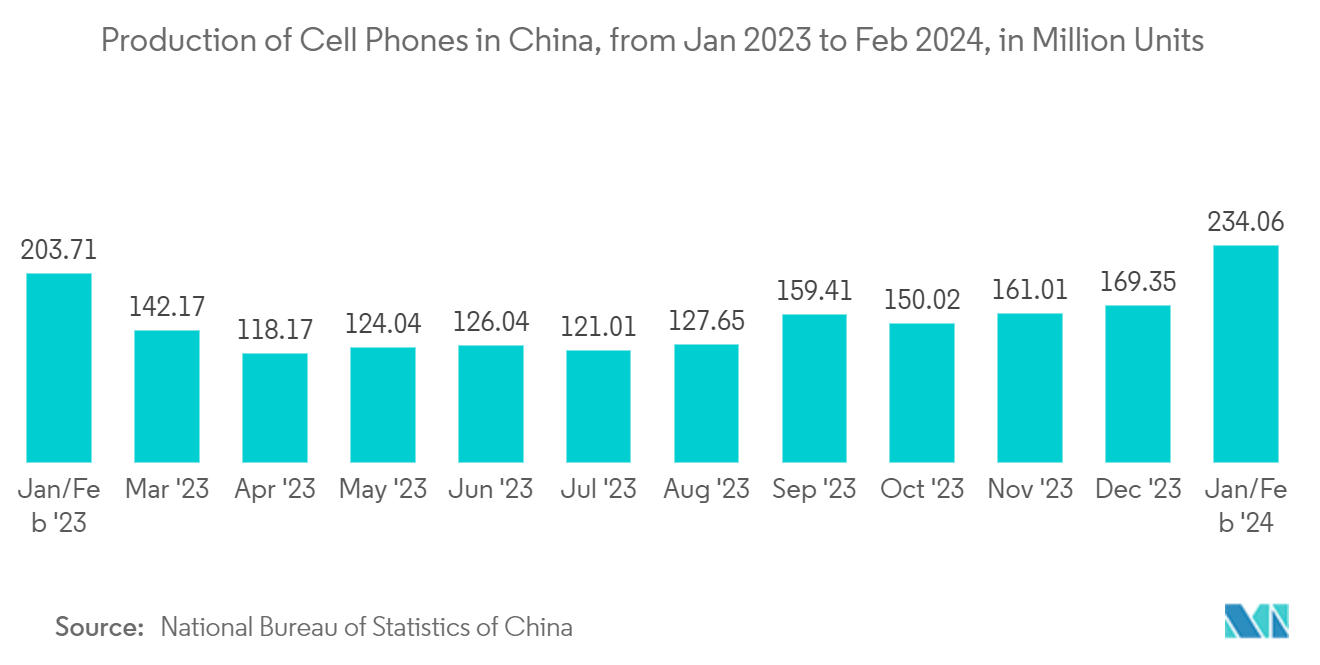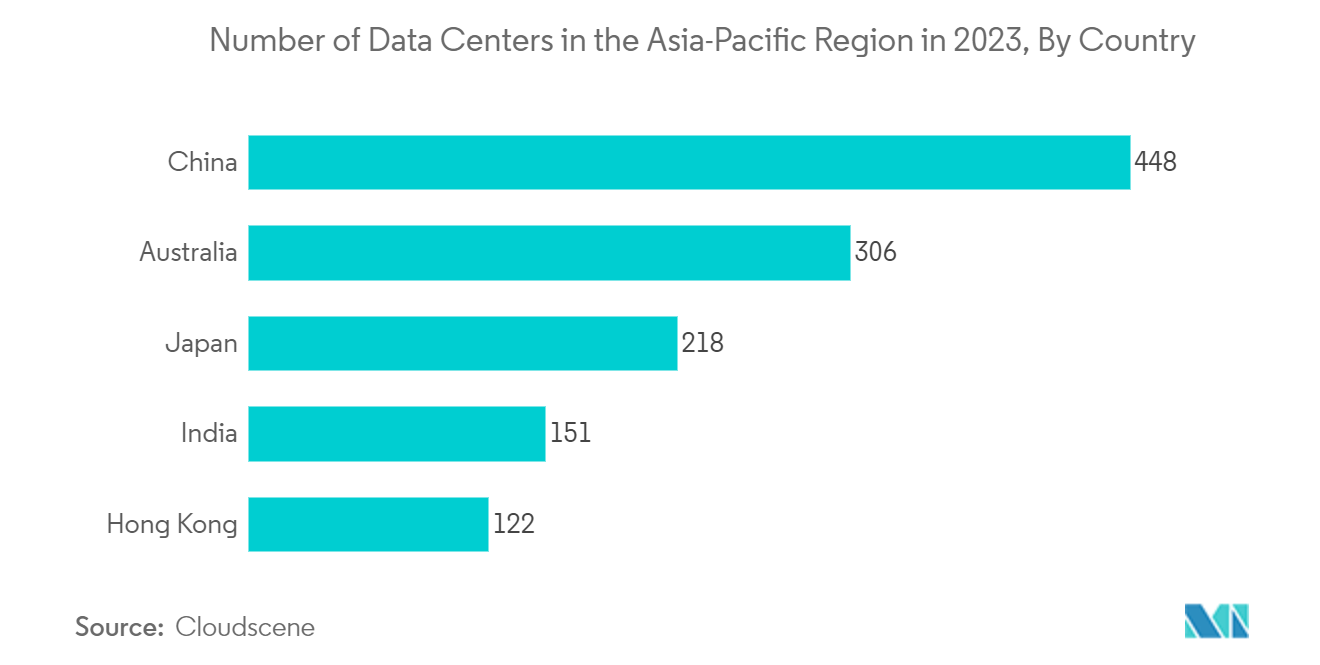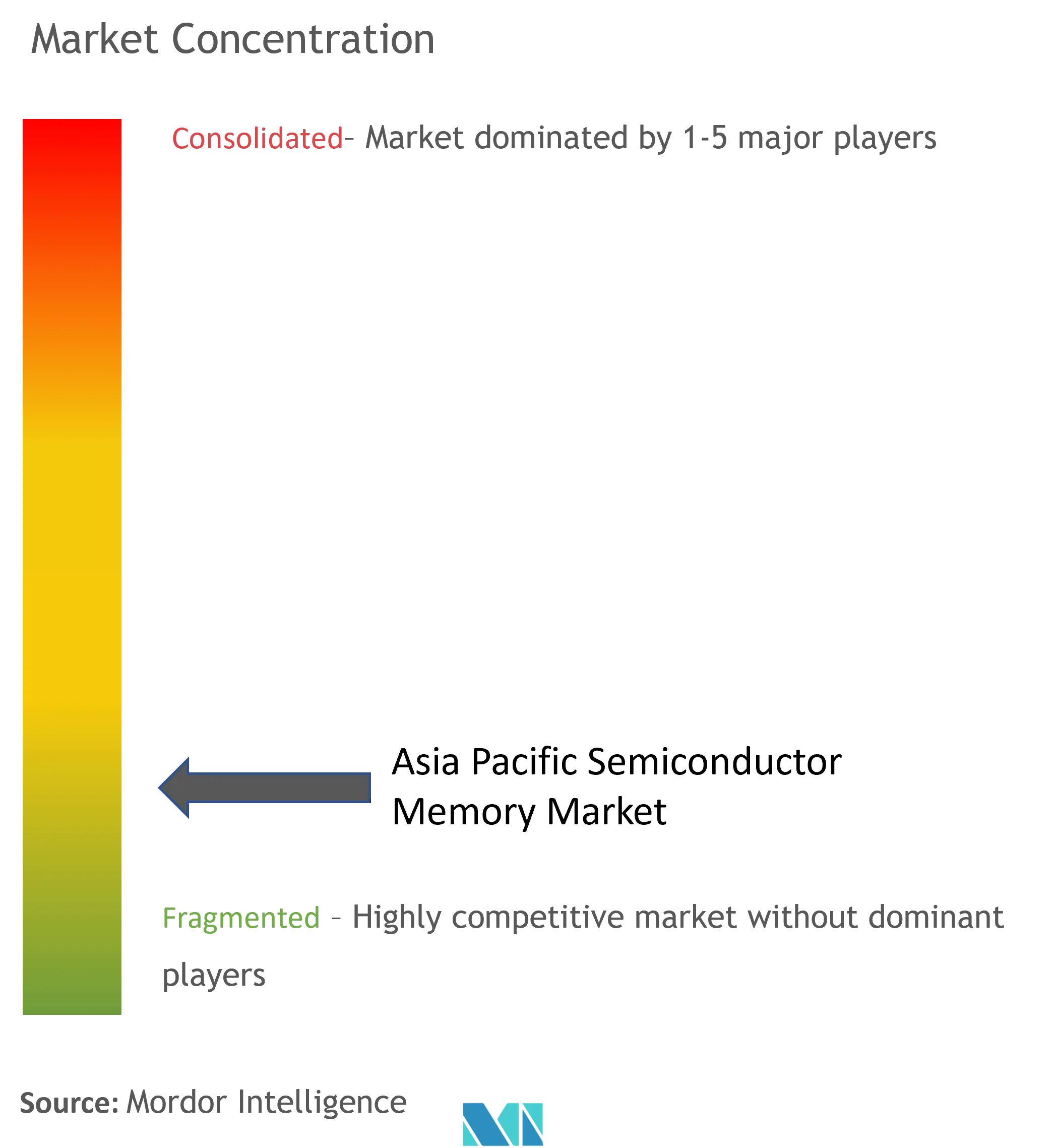Asia Pacific Semiconductor Memory Market Size

| Study Period | 2019 - 2029 |
| Base Year For Estimation | 2023 |
| Market Size (2024) | USD 37.5 Billion |
| Market Size (2029) | USD 89.90 Billion |
| CAGR (2024 - 2029) | 19.10 % |
| Market Concentration | Low |
Major Players*Disclaimer: Major Players sorted in no particular order |
Asia Pacific Semiconductor Memory Market Analysis
The Asia Pacific Semiconductor Memory Market size is estimated at USD 37.5 billion in 2024, and is expected to reach USD 89.90 billion by 2029, growing at a CAGR of 19.10% during the forecast period (2024-2029).
- The market has different types of memory, such as DRAM, SRAM, NOR Flash, NAND Flash, ROM, and EPROM. Semiconductor memory refers to various electronic data storage devices that find applications as computer memory in computers (PCs and laptops), consumer devices (cameras and phones), commercial IT applications (telecom and data centers), traditional industrial applications, and the emerging spectrum of IoT applications.
- The automotive sector is witnessing increased demand for DRAM semiconductors. One of the major factors driving the demand is the growing emphasis on autonomous driving technologies with built-in 5G infrastructure. For instance, Tesla has adopted Nvidia’s CPU and GPU solutions, which drove them to incorporate GDDR5 DRAM products.
- Semiconductor memories have become a key component of success in data centers that store and manage data. Memory devices are expected to handle huge volumes of data with high bandwidth, and high performance has to be demonstrated with optimized cost and low power consumption.
- Also, the rapid expansion of data centers in the region is expected to be among the most significant drivers behind this growth, as data centers are growing continuously due to digitization and information technology scale-up. For instance, in March 2023, OVHcloud announced the construction of its first data center in India as part of its Asia-Pacific expansion plans. The company will also deploy two additional data centers in Australia and Singapore.
- The industrial sector in Asia-Pacific has also witnessed significant growth due to the technological transformation of the industrial sector toward Industry 4.0. It is, hence, expected to become a significant demand driver for semiconductor memory as more and more electrical/electronic devices are being incorporated into industries to support automation, AI, and analytics solutions.
- Post-COVID-19, the demand for the market has significantly enhanced due to the growing demand for consumer electronic devices such as tablets, smartphones, and wearables. It is expected to witness stable growth as consumers increasingly rely on digital technologies and solutions for various day-to-day activities.
Asia Pacific Semiconductor Memory Market Trends
Increasing Demand for Consumer Electronics Will Drive Market Growth
- The consumer electronics industry is among the critical consumers of semiconductor memory as these components are vital in the charging infrastructure of consumer electronic devices. Hence, they are widely used with smartphones, computers, and several other electronic devices.
- In recent years, the adoption of electronic devices has increased significantly. The growing internet penetration, rising disposable income driving affordability, and the growing awareness of digital technologies are crucial factors behind this growth.
- The increasing penetration of tablets, smartphones, and other handheld computing devices supports the market’s growth. For instance, according to Ericsson, the number of smartphone subscriptions is anticipated to develop at a CAGR of 5%, reaching over 1.14 billion by 2028 in India from 840 million after 2022. Cell phone subscriptions in China stood at 234.06 million units in January and February 2024, increasing from 203.71 million units in January and February 2023. Such trends create a favorable scenario for the growth of the market.
- According to IBEF, India aims to achieve electronics manufacturing worth USD 300 billion in electronics exports of USD 120 billion by FY26. Additionally, in 2022-2023, India produced wearables such as earphones and smartwatches worth USD 970.31 million.
- Smart cities and smart homes are among the latest trends in consumer electronics. As these trends govern a higher adoption of connectivity technology in consumer appliances, household appliance manufacturers increasingly focus on integrating IoT technologies with products to help consumers stay connected with their homes.
- Several leading players are focusing on strategic partnerships and expanding their regional production capacities to fulfill the growing demand. For instance, in March 2023, Winbond and STMicroelectronics announced a strategic alliance to combine high-performance memory with STM32 devices in consumer and smart industrial applications.

China to Hold Significant Market Share
- Technological development in the consumer electronic device industry over the years has facilitated widespread adoption of these devices, which, in turn, is creating a favorable scenario for the market's growth.
- According to China's Ministry of Industry and Information Technology, the country ranks first globally in the production and sales of consumer electronics owing to its improved innovation and brand-building capacity. To continue to remain the major stakeholder in the consumer electronics sector, the government is making several efforts to boost productivity, computing, storage, and display industrial supply chains, along with integrating and innovating the development of new technologies in key industries.
- Another driving force is the growth of autonomous vehicles in this region. The Chinese government has been formulating technology standards and industry guidelines for autonomous vehicles. Beijing became the country's first city to allow open road tests for autonomous cars.
- Several leading players in the country are focusing on supporting the adoption of autonomous cars, thus fueling the market growth. For instance, in October 2023, Xpeng, a Chinese electric vehicle (EV) startup, announced expanding the use of its advanced driver assistance system (ADAS) to 50 mainland cities to maintain an edge over the competitors in smart driving capabilities.
- The increasing demand for data centers also boosts the demand for memory components. For instance, in October 2023, local authorities announced that China's southwestern Province of Guizhou has 39 significant data centers in operation or under construction.
- Overall, the rising data centers and automotive sectors are expected to create massive demand for the market, and the demand from the consumer electronics sector is expected to be constant during the forecast period.

Asia Pacific Semiconductor Memory Industry Overview
The Asia-Pacific semiconductor memory market is highly competitive owing to various vendors providing memory to the domestic and international markets. The market appears fragmented, with significant vendors adopting strategic partnerships, mergers, and acquisitions strategies to expand their reach and stay competitive. Some major players in the market are Samsung Electronics Co. Ltd, Micron Technology Inc., SK Hynix Inc., and ROHM Co. Ltd. Some of the recent developments in the market are:
In August 2023, SK Hynix announced that it successfully developed HBM3E, the next generation of high-end DRAMs for AI applications. The latest product not only meets the industry’s highest standards of speed, which is the critical specification for AI memory products, but all categories include capacity, heat dissipation, and user-friendliness.
In July 2023, Samsung Electronics announced that it completed the development of the industry’s first Graphics Double Data Rate 7 (GDDR7) DRAM. It will first be installed in next-generation systems of critical customers for verification this year, driving the future growth of the graphics market and further consolidating Samsung’s technological leadership in the field.
Asia Pacific Semiconductor Memory Market Leaders
-
Samsung Electronics Co. Ltd
-
Micron Technology Inc.
-
SK Hynik Inc.
-
ROHM Co. Ltd.
-
STMicroelectronics NV
*Disclaimer: Major Players sorted in no particular order

Asia Pacific Semiconductor Memory Market News
- March 2024: Giantec launched serial NOR flash memory chips with enhanced read and write speeds. Leveraging innovative circuit designs and advanced manufacturing techniques, these chips offer lightning-fast performance, resulting in quicker boot times, smoother multitasking, and improved overall system responsiveness.
- June 2023: Micron Technology Inc. planned to construct a new assembly and test facility in Gujarat, India. The company’s new facility will enable assembly and test manufacturing for DRAM and NAND products and address the demand from international and domestic markets.
Asia Pacific Semiconductor Memory Market Report - Table of Contents
1. INTRODUCTION
1.1 Study Assumptions and Market Definition
1.2 Scope of the Study
2. RESEARCH METHODOLOGY
3. EXECUTIVE SUMMARY
4. MARKET INSIGHTS
4.1 Market Overview
4.2 Industry Attractiveness - Porter's Five Forces Analysis
4.2.1 Bargaining Power of Suppliers
4.2.2 Bargaining Power of Consumers
4.2.3 Threat of New Entrants
4.2.4 Threat of Substitutes
4.2.5 Intensity of Competitive Rivalry
4.3 Technology Snapshot
4.4 Impact of Macroeconomic Factors on the Market
5. MARKET DYNAMICS
5.1 Market Drivers
5.1.1 Increasing Demand for Consumer Electronics
5.1.2 Growing Demand for Semiconductor Memory in Advanced Automotive Applications
5.2 Market Challenges
5.2.1 Fluctuations in the Raw Material Price
6. MARKET SEGMENTATION
6.1 By Type
6.1.1 DRAM
6.1.2 SRAM
6.1.3 NOR Flash
6.1.4 ROM & EPROM
6.1.5 Other Types
6.2 By Application
6.2.1 Consumer Products
6.2.2 PC/Laptops
6.2.3 Smartphone/Tablet
6.2.4 Data Centers
6.2.5 Automotive
6.2.6 Other Applications
6.3 By Country
6.3.1 China
6.3.2 India
6.3.3 Japan
6.3.4 South Korea
7. COMPETITIVE LANDSCAPE
7.1 Company Profiles
7.1.1 Samsung Electronics Co. Ltd
7.1.2 Micron Technology Inc.
7.1.3 SK Hynix Inc.
7.1.4 ROHM Co. Ltd
7.1.5 STMicroelectronics NV
7.1.6 Maxim Intergated Products Inc.
7.1.7 IBM Corporation
7.1.8 Cypress Semiconductor Corporation
7.1.9 Intel Corporation
7.1.10 Nvidia Corporation
7.1.11 Kioxia Corporation
- *List Not Exhaustive
8. INVESTMENT ANALYSIS
9. FUTURE OF THE MARKET
Asia Pacific Semiconductor Memory Industry Segmentation
Semiconductor memory is a digital electronic semiconductor device that stores digital information like computer memory. The Asia-Pacific semiconductor memory market is segmented by type (DRAM, SRAM, NOR Flash, NAND Flash, and ROM & EPROM), application (consumer products, PC/laptop, smartphone/tablet, data center, and automotive), and geography. The report offers market size and forecasts for all the above segments in value (USD).
| By Type | |
| DRAM | |
| SRAM | |
| NOR Flash | |
| ROM & EPROM | |
| Other Types |
| By Application | |
| Consumer Products | |
| PC/Laptops | |
| Smartphone/Tablet | |
| Data Centers | |
| Automotive | |
| Other Applications |
| By Country | |
| China | |
| India | |
| Japan | |
| South Korea |
Asia Pacific Semiconductor Memory Market Research FAQs
How big is the Asia Pacific Semiconductor Memory Market?
The Asia Pacific Semiconductor Memory Market size is expected to reach USD 37.5 billion in 2024 and grow at a CAGR of 19.10% to reach USD 89.90 billion by 2029.
What is the current Asia Pacific Semiconductor Memory Market size?
In 2024, the Asia Pacific Semiconductor Memory Market size is expected to reach USD 37.5 billion.
Who are the key players in Asia Pacific Semiconductor Memory Market?
Samsung Electronics Co. Ltd, Micron Technology Inc., SK Hynik Inc., ROHM Co. Ltd. and STMicroelectronics NV are the major companies operating in the Asia Pacific Semiconductor Memory Market.
What years does this Asia Pacific Semiconductor Memory Market cover, and what was the market size in 2023?
In 2023, the Asia Pacific Semiconductor Memory Market size was estimated at USD 30.34 billion. The report covers the Asia Pacific Semiconductor Memory Market historical market size for years: 2019, 2020, 2021, 2022 and 2023. The report also forecasts the Asia Pacific Semiconductor Memory Market size for years: 2024, 2025, 2026, 2027, 2028 and 2029.
Asia Pacific Semiconductor Memory Industry Report
Statistics for the 2024 Asia Pacific Semiconductor Memory market share, size and revenue growth rate, created by Mordor Intelligence™ Industry Reports. Asia Pacific Semiconductor Memory analysis includes a market forecast outlook for 2024 to 2029 and historical overview. Get a sample of this industry analysis as a free report PDF download.



